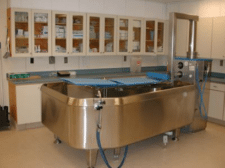Modalities Utilized in Wound Healing- Whirlpool
Continuing on in our series on modalities used in wound management, this week we’ll cover whirlpool, including its indications, contraindications and advantages over other wound care modalities.
Functions of Whirlpool
Whirlpool was initially reserved as a method of debridement for patients who had suffered burns. Today, whirlpool is used much more extensively and serves a variety of purposes, including:
- Helps to remove debris and surface bacteria/contamination
- Decreases wound pain and fever
- Helps to remove dressings that have adhered to the wound bed
Indications/Precautions
Whirlpool is typically used in the management of wounds that have not healed or that have stalled in the progression of healing. It is also used for wounds that have large amounts of necrotic tissue that must be removed.
How to Perform
There are two main types of whirlpool, immersion and showering. The steps involved in the immersion technique are as follows:
- Fill the whirlpool receptacle, leaving enough room for displacement once the patient (or body part) has been immersed.
- Maintain the recommended temperature, between 92 and 98°F for small whirlpools and slightly warmer for whirlpool tubs that the patient will be fully immersed in. Do not exceed 102°
- Expose the area to be treated, removing any dressings. Dressings that have adhered to the wound or periwound area can be soaked off prior to starting the turbine.
- Adjust the turbine to ensure it is in the correct position and that the force of flow is adequate.
- Aim for 10 to 20 minutes of whirlpool therapy- longer if there is hardened necrotic tissue, less if adherent tissue is soft or the wound bed is very fragile.
- Debridement may be performed during therapy (with the turbines off).
- Once treatment has been completed, dry intact skin with a towel. Leave the wound open to air or pat dry with sterile gauze; alternately, you may cover the wound with a sterile drape.
- Consider irrigating the wound following whirlpool therapy, as this has been shown to remove up to four times as much bacteria than whirlpool alone.
- Dress the wound, performing any measurements or other interventions as necessary.
When using the showering technique, the affected area is positioned over the empty whirlpool receptacle and the wound is sprayed with water at a temperature of 92 to 98°F.
Patient Considerations
Prior to the first whirlpool session, you should explain the purpose and steps to the patient, ensuring that they understand the procedure. The patient should be draped appropriately for modesty. Patients who are to be fully immersed may wear a gown or shorts in the whirlpool tub. Some patients may benefit from pain medication prior to whirlpool therapy, especially if debridement is to be performed during therapy. Remember to wear appropriate barrier devices to prevent exposure to splash injury.
Advantages/Disadvantages
Whirlpool therapy can increase comfort and is highly conducive to debridement. Whirlpool therapy can be performed in a variety of settings and is highly effective at irrigating and/or debriding wounds, particularly large wounds that would be difficult to debride elsewhere. Disadvantages include the possibility of wound overhydration and maceration of the periwound. There is also the risk of cross-contamination unless strict guidelines are followed for cleaning of the whirlpool tub and equipment. Whirlpool therapy is expensive in terms of personnel time and costs associated with set up, cleaning and maintenance.
This is the second in a series of articles that will lead you through most of the electrotherapeutic, physical and mechanical modalities used in wound care today. Visit Wound Educators weekly to follow our series.
If you are interested in wound care management, visit Wound Educators to get the latest information in wound care. Interested in becoming at certified wound care practitioner? Wound educators has a course designed especially for you. Contact us if you have questions or require further information.
Sources:
Tao, H., Butler, J. & Luttrell, T. (2012). The role of whirlpool in wound care. J Am Coll Clin Wound Spec. Mar: 4(1); pg. 7-12.
Perry, A., Potter, P. & Ostendorf, W. (2013). Clinical Nursing Skills and Techniques. 8th edition. Elsevier Health Sciences.


Hello.. I am a physical therapist with 37 years of wound care experience.. a sterile whirlpool with chlorazene as an additive, debridement and rinse with saline when through.. apply triple antibiotic or A and D. Petroleum around the edge of the wound to prevent maceration and silvadene cream on the wound bed works great. Alevyne foam dressing on bony prominences such as heals work great. Also, whirlpool does not have to be expensive!
Marilyn Prior, PT
Hi Marilyn-
Thanks for your comment. What protocol do you follow for cleaning/ sterilizing your whirlpool and what products do you recommend?
Thanks so much
Heather Williamson